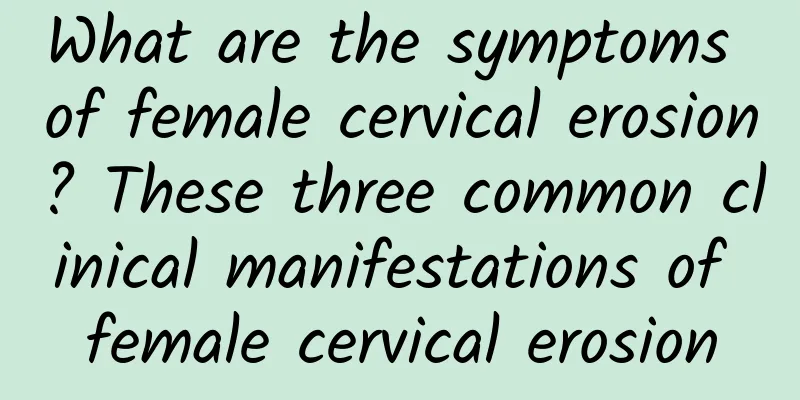What are the symptoms of female cervical erosion? These three common clinical manifestations of female cervical erosion

|
Cervical erosion is a very common gynecological disease, especially for married women. Almost half of them have cervical erosion to varying degrees, but many women themselves do not know that cervical erosion can be mild, moderate, or severe. As a woman, only by knowing the symptoms of cervical erosion can you know whether you have been patronized by this inflammation. So what are the symptoms of cervical erosion? Symptoms of cervical erosion Cervical erosion is caused by inflammation, which causes the epithelial cells covering the surface of the cervix to fall off, while the columnar epithelial cells underneath protrude outward and replace the fallen epithelial cells. Because the capillaries of the columnar epithelium are exposed, the inflamed area appears bright red, so it is called cervical erosion, but it is not true erosion. Clinically, it is divided into simple, granular and papillary types according to the surface condition of the cervix, and also divided into mild, moderate and severe degrees according to the ratio of the erosion area to the surface of the cervix. 1. Increased leucorrhea Increased leucorrhea is the main symptom of cervical erosion, and sometimes even the only symptom. Due to the different pathogens, as well as the differences in the scope and degree of erosion, the properties of leucorrhea are also different. If the inflammatory infection is not obvious, the leucorrhea will mainly be transparent mucus; if the cervical erosion is accompanied by obvious inflammatory infection, the leucorrhea will be yellow, purulent and viscous. If the erosion area is small or the lesion is shallow, the amount of leucorrhea may be less; if it is a severe erosion with a deeper lesion and a larger area, the amount of leucorrhea will be more, and occasionally it may contain a small amount of blood or blood. Some patients may sometimes complain of contact bleeding 2. Pain: Pain symptoms of cervical erosion are rare. When the pathogens spread to a deeper area, it can cause chronic paracervical connective tissue inflammation, resulting in lumbar pain, pelvic pain and dysmenorrhea. If the inflammation spreads to the main ligament, sexual intercourse pain may occur, affecting sexual life. 3. Bladder symptoms Inflammation of the cervix can spread or directly spread to the bladder triangle, thereby stimulating the bladder and causing symptoms of frequent urination and painful urination, and sometimes secondary urinary tract infection. |
>>: What foods are good for cervical erosion? Dietary treatment for cervical erosion in women
Recommend
Pay attention to the issues that need to be paid attention to in the care of dysmenorrhea
There are often various problems in the care of d...
Is threatened miscarriage a serious problem?
Women are very weak during pregnancy. Threatened ...
Why is endometriosis prone to recurrence?
For many women, the occurrence of endometriosis c...
How to treat multiple uterine fibroids?
How to treat multiple uterine fibroids? You shoul...
Methods for diagnosing and treating third degree cervical erosion
Among gynecological diseases, cervical erosion is...
What are the consequences of incomplete treatment of pelvic inflammatory disease?
What are the consequences of incomplete treatment...
Cleanse the intestines and detoxify! 11 must-drink slimming teas
For many busy office workers, they rely on eating...
Which hospital is better for treating congenital absence of vagina?
Congenital absence of vagina is very harmful. Onc...
What vegetables can prevent uterine fibroids? What vegetables can help uterine fibroids?
What vegetables can prevent uterine fibroids? Ute...
What are the clinical manifestations of primary dysmenorrhea?
Dysmenorrhea is a common physiological phenomenon...
How to choose a specialized hospital for the treatment of vulvar leukoplakia
How to choose a specialized hospital for the trea...
How can women prevent pelvic effusion?
Pelvic effusion is generally caused by inflammati...
Drinking 4 cups of coffee a day reduces risk of type 2 diabetes
After getting up in the morning or before going t...
How to supplement nutrition after uterine fibroid surgery? What is the average age of onset of uterine fibroids?
Uterine fibroids are mostly multiple, and there a...
Why do uterine fibroids appear sometimes and disappear sometimes?
Why do uterine fibroids sometimes not appear? Ute...









